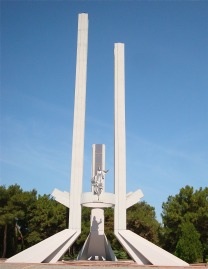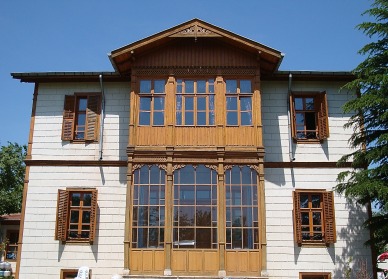“Elm Tree” suburb Population: 3,000
Old name: Orestias (Greek)
Karaağac is really just a southern suburb of Edirne, albeit one that’s separated from the town centre by a lengthy strip of Kent Orman (City Forest). It’s a sleepy place of mainly one-storey houses with gardens set in tree-lined streets. The main focus of interest is the huge station that the architect Kemaleddin Bey (1870-1927) built for Edirne and that now houses Trakya University’s Fine Arts Dept. It’s not his finest work, being somewhat on the top-heavy side. However, the grounds are also home to a redundant steam train and, more importantly, to the Losan Anıtı (Lausanne Monument).
This monument commemorates the 1923 Treaty of Lausanne that defined Turkey’s borders after the Turkish War of Independence. It features a women holding aloft a copy of the document and a dove, and stands on three legs said to symbolise Thrace, Anatolia and Karaağac itself. Nearby a small Losan Müsezi (Lausanne Museum) is only open on weekdays. A cafe is housed in an imposing building that once formed part of the station complex.
Nearby a small Losan Müsezi (Lausanne Museum) is only open on weekdays. A cafe is housed in an imposing building that once formed part of the station complex.
More cafes lurk by the gates of the complex but the most interesting places to stop for a meal are back on the road towards Edirne where a fake windmill acts as a landmark.
Turn left at the windmill as you return to Edirne to find the Tarihi Edirne Konağı (Historic Edirne Mansion), a grand house in a large garden that once belonged to Dr Bahattin Oğutmen. Stop for a snack here and you will get to see what the houses of the elite looked like in the early 20th century. Its ceiling frescoes have been carefully restored.
 Tarihi Edirne Konağı (Historic Edirne Mansion)Right beside the fake windmill stands a huge building in a lovely garden that was once a buzhane (ice house) and briefly served as a church for local French and Italians. It may have been turned into a hotel with views across to the Selimiye Cami in Edirne town centre from its top floor.
Tarihi Edirne Konağı (Historic Edirne Mansion)Right beside the fake windmill stands a huge building in a lovely garden that was once a buzhane (ice house) and briefly served as a church for local French and Italians. It may have been turned into a hotel with views across to the Selimiye Cami in Edirne town centre from its top floor.
Transport info
Minibuses to Karaağac run down Maarif Caddesi in Edirne or you can walk the two km from the Meriç Köprüsü (Bridge).
Greek border
From Karaağaç you can cross into Kastanies in Greece via the border at Pazarkule.
The Treaty of Lausanne, signed on 24 July 1923 at the end of the Turkish War of Independence, effectively laid the foundations for the Turkish Republic by defining all of its borders except the one with Iraq. İsmet İnönü signed the treaty on behalf of Turkey while Eleftherios Venizelos signed on behalf of Greece and Lord Curzon on behalf of the British. The treaty granted Karaağaç to Turkey even though it was on the west bank of the Meriç river and therefore technically in Western Thrace as compensation for war damage.


